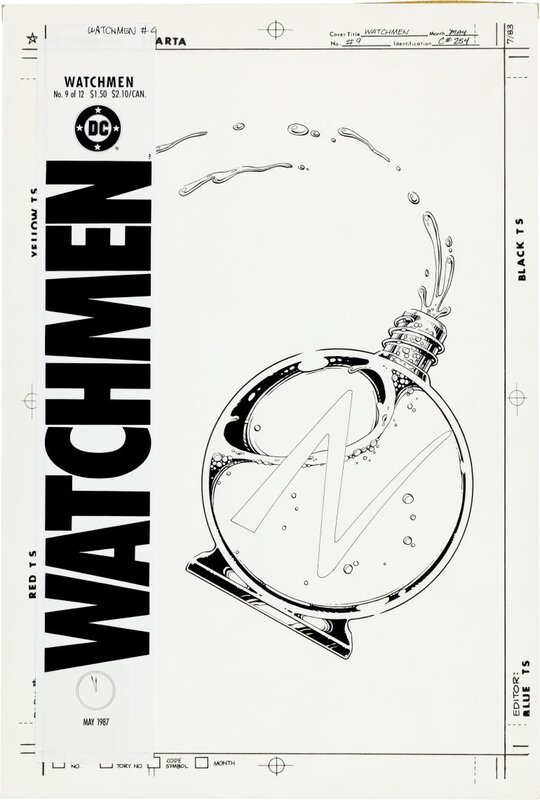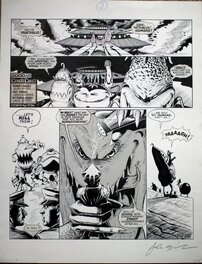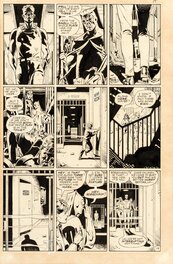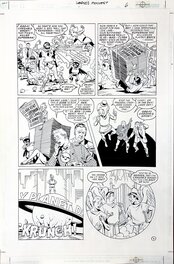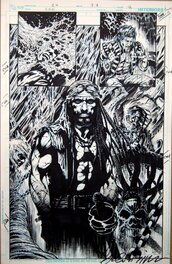Dans la collection de ChrisK
Description
Watchmen - cover to issue 9 from May 1987
Commentaire
This chapter was entitled ‘The Darkness of Mere Being’, a partial quote taken from Carl Jung’s ‘Memories, Dreams, Reflections’- “As far as we can discern, the sole purpose of human existence is to kindle a light of meaning in the darkness of mere being.” The use of the quote is certainly not accidental – it effectively encompasses Laurie Juspezcyk’s arguments to Dr. Manhattan over the world’s fate at the chapter’s end (mercifully, she wins the argument that all of human life is worth saving).
The piece fell into the category of ‘have to have’ for numerous reasons. First...‘Nostalgia’. It’s almost the equivalent of a law of physics in comic art collecting – a powerful, naturally occurring phenomenon that, while not able to be seen, is an undeniably and regularly present cosmic glue to the hobby. Type this word into a web search and the first two definitions that pop up are, 1) a sentimental longing for the past, typically for a period or place with happy personal associations, and 2) the evocation of these feelings or tendencies, especially in commercialized form. That second definition hits awfully close to home when I think of my comic art collection.
Nostalgia was originally described as a “neurological disease of essentially demonic cause” by Johannes Hoffer, the Swiss doctor who coined the term in 1688. He attributed soldiers’ mental and physical maladies to a longing to return home, combining the Greek words for home (nostos) and the accompanying pain (algos) to create ‘nostalgia’. But science since the late 1990’s (interestingly, well after the publication of ‘Watchmen’) has turned that view on its head. While feeling nostalgic has historically been seen as a sign of depression, a growing body of research suggests that it actually wards off depression and anxiety. Nostalgic thoughts are remarkably similar across cultures – time with close friends, weddings, holidays, etc. – and such reminiscences are often triggered by feelings of isolation, most commonly amongst people experiencing a transition. Despite arising from senses of loss, nostalgia makes us feel better by bringing to mind cherished memories that assure us we are valued people who have meaningful lives. I enjoy that something from the hobby evokes an aspect that is so confirmatory about the positives of engaging in it.
The second reason for the ‘have to have’ is the importance of the image and theme to the story. The ‘Nostalgia’ of Watchmen appears in some manner in every issue of the series – as a billboard, a store sign, a magazine ad, a tattered advertising poster in an alley, a television ad and a bottle of perfume on the dresser of Sally Jupiter – with the exception of issue six (it’s the Rorschach origin issue and he clearly has no longing for his past - the concept and image would be totally out of place). But in every other chapter of the story ‘Nostalgia’ is present – and is representative of the characters' reminiscences, memories and flashbacks of 'modified visions of a half-imagined past' as they deal with an unstable present and uncertain future.
Nostalgia is particularly notable in chapter 9 – it’s the critical issue of the book as looking back to the past stops and the narrative turns to transitioning to the future. The tumbling bottle of Nostalgia throughout the chapter mirrors Laurie Juspezcyk’s emotional journey as she confronts the truth of her past. And, its destruction marks the shift of focus from looking back to looking forward – eventually reflected in the rollout of the new Veidt fragrance, ‘Millennium’.
All in all, delighted to have this piece of comic art history in my gallery.
The piece fell into the category of ‘have to have’ for numerous reasons. First...‘Nostalgia’. It’s almost the equivalent of a law of physics in comic art collecting – a powerful, naturally occurring phenomenon that, while not able to be seen, is an undeniably and regularly present cosmic glue to the hobby. Type this word into a web search and the first two definitions that pop up are, 1) a sentimental longing for the past, typically for a period or place with happy personal associations, and 2) the evocation of these feelings or tendencies, especially in commercialized form. That second definition hits awfully close to home when I think of my comic art collection.
Nostalgia was originally described as a “neurological disease of essentially demonic cause” by Johannes Hoffer, the Swiss doctor who coined the term in 1688. He attributed soldiers’ mental and physical maladies to a longing to return home, combining the Greek words for home (nostos) and the accompanying pain (algos) to create ‘nostalgia’. But science since the late 1990’s (interestingly, well after the publication of ‘Watchmen’) has turned that view on its head. While feeling nostalgic has historically been seen as a sign of depression, a growing body of research suggests that it actually wards off depression and anxiety. Nostalgic thoughts are remarkably similar across cultures – time with close friends, weddings, holidays, etc. – and such reminiscences are often triggered by feelings of isolation, most commonly amongst people experiencing a transition. Despite arising from senses of loss, nostalgia makes us feel better by bringing to mind cherished memories that assure us we are valued people who have meaningful lives. I enjoy that something from the hobby evokes an aspect that is so confirmatory about the positives of engaging in it.
The second reason for the ‘have to have’ is the importance of the image and theme to the story. The ‘Nostalgia’ of Watchmen appears in some manner in every issue of the series – as a billboard, a store sign, a magazine ad, a tattered advertising poster in an alley, a television ad and a bottle of perfume on the dresser of Sally Jupiter – with the exception of issue six (it’s the Rorschach origin issue and he clearly has no longing for his past - the concept and image would be totally out of place). But in every other chapter of the story ‘Nostalgia’ is present – and is representative of the characters' reminiscences, memories and flashbacks of 'modified visions of a half-imagined past' as they deal with an unstable present and uncertain future.
Nostalgia is particularly notable in chapter 9 – it’s the critical issue of the book as looking back to the past stops and the narrative turns to transitioning to the future. The tumbling bottle of Nostalgia throughout the chapter mirrors Laurie Juspezcyk’s emotional journey as she confronts the truth of her past. And, its destruction marks the shift of focus from looking back to looking forward – eventually reflected in the rollout of the new Veidt fragrance, ‘Millennium’.
All in all, delighted to have this piece of comic art history in my gallery.
5 commentaires
Pour laisser un commentaire sur cette œuvre, veuillez vous connecter
A propos de Dave Gibbons
Dave Gibbons est un scénariste et dessinateur de comics britannique. Il dessine de nombreuses couvertures et des récits pour quasiment tous les personnages de DC. En 1986, il collabore avec Alan Moore sur la série limitée Watchmen qui révolutionne les comics.

